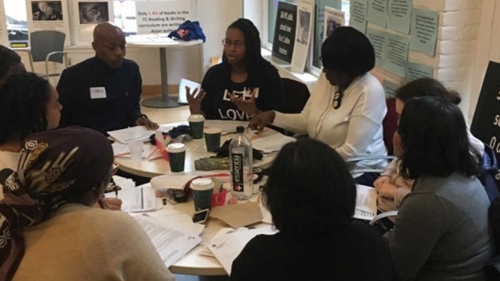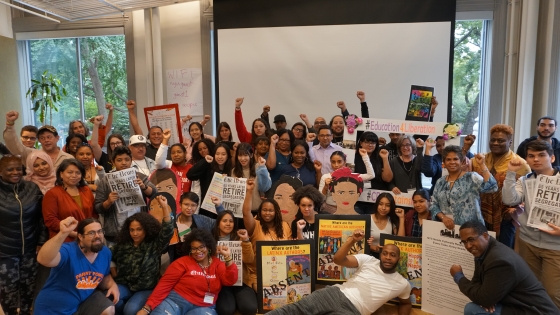Download the 2023 Culturally Responsive ELA Curriculum Scorecard
Use the button below to download the scorecard
2023 Culturally Responsive ELA Curriculum ScorecardThe new version of the Scorecard incorporates feedback from users and includes enhanced guidance and a stronger emphasis on gender, ability and language.
The revised Scorecard also emphasizes the need to use this tool collaboratively through participatory evaluation with communities most directly impacted by the curriculum.
Download the 2019 Culturally Responsive English Language Arts Curriculum Scorecard
Use the buttons below to download the scorecard
Scorecard In English Scorecard in En Español Share Your Scorecard ResultsCulturally Responsive STEAM Curriculum Scorecard
Download Culturally Responsive STEAM Curriculum Scorecard
Dr. Leah Q. Peoples, Elzora Cleveland, Derrick Owens, and other parent leaders with the NYC Coalition for Educational Justice, score New York City curriculum
The Culturally Responsive Curriculum Scorecards were developed collaboratively by NYC parents, students, educators and researchers, as a tool to help determine the extent to which English Language Art, Science, Technology, Engineering, Arts, and Mathematics (STEAM) curricula are (or are not) culturally responsive.
The tool was spearheaded by Black and Latinx public school parents with the NYC Coalition for Educational Justice, who were organizing to push the NYC Department of Education to provide their children with a culturally responsive education and wanted to know if their children’s curriculum perpetuated racism and other forms of bias. Together, parents and researchers developed and piloted the Scorecard, which has now been used in hundreds of schools and districts across the country and internationally.
What is Curriculum?
People use the word “curriculum” to mean very different things. In this context, curriculum means the detailed package of learning goals; units and lessons that lay out what teachers teach each day and week; assignments, activities and projects given to students; and books, materials, videos, presentations, and readings used in the class. Curriculum can take the form of a textbook and teacher’s manual bought from a publisher, a notebook of lesson plans pulled together from various sources, or a reading list with a packet of matching activities created by teachers. Curriculum is different from a syllabus, which is an outline of the topics covered in the class; a booklist, which is a list of readings without activities; and standards, which are the expectations for what students should know at each grade level. Standards are what students should know and be able to do, and curriculum lays out how students will learn to do it.
- Textbooks
- Lesson Plans
- Stories/Books
- Worksheets and Homework Assignments
- Teacher's Manuals
- Media/Videos
- Learning Standards/Expectations
- Tests
- Class Activities
How to Use the Scorecard
We have designed this scorecard so that it can be customized to the context and conditions of your school district and campaign. Completing the entire document will give you the most comprehensive analysis of how culturally responsive your curriculum is. If you don’t have the time or capacity to do that, you can complete an individual section and get a more limited assessment. We designed this specifically with K-12th grade English Language Arts and STEAM subject curricula in mind, but feel free to try it with other grades and subjects as well. If your school doesn’t have a set curriculum, you can also use this tool to assess the diversity of the school or classroom library.
The Seven Steps To Complete Your Curriculum Scorecard
- Get your child’s/school’s curriculum.
Go to your teacher, principal, or district office, and ask to see your child’s or school’s curriculum. In many districts, there is a Parent Bill of Rights that gives parents the right to access their child’s curriculum. If the school is using a commercial curriculum, ask for a copy or the name and publisher so you can look it up online. (If you need to purchase it, NYU Metro Center can help). If the school is using a homemade curriculum, ask for a copy, or at least a sample of a few months of lesson materials. If they refuse to give you the curriculum, take your request to a higher level in the district, or discuss with your team to decide next steps. - Select your curriculum evaluation team.
The curriculum scorecard will work best if you have a team of at least 3 people with diverse identities (racial, gender, age, sexuality, class, national origin) and roles (parent, student, teacher, administrator, community member) who work together to evaluate the curriculum. These people do not have to be education professionals or have prior experience with evaluation. The more people, the better! - Choose the grades, units, and lessons to analyze.
Curricula can be thousands of pages, so you will need to select one or a few grades, units, and lessons to focus on (a sample of the larger curricula). The units you choose should not focus specifically on diversity and multiculturalism; they should be typical units. If you are able to cover more than one grade, select at least one lower and one upper grade. - Pull out keywords that represent each statement that the evaluation team can look for.
Once you have your curriculum and the scorecard in hand, review the statements for the scorecard you will begin with (Representation, Social Justice or Teachers Materials). Make sure the team understands each statement, and refer to the Glossary and Explanations with any questions. Chart key words, ideas and qualities from the statements that you will be looking for as you read the curriculum. This will help ensure that as you read, you are focused on the information you’ll need in order to effectively score. - Conduct the evaluation.
The scorecard asks for your level of satisfaction with the curriculum on various measures. There is no right answer; this is just your opinion as someone who cares about culturally responsive education. As you answer each statement, use the Scoring Guidelines to help you decide your ratings. - Score the evaluation.
Tally your score for each section of the scorecard. A curriculum may excel in one area and fall short in another, and it is important to record those differences. You should come out with one score for each of the following sections: + Character Tally + Author Tally + Representation + Social Justice + Teachers Materials - Discuss with your team.
Discuss the process with your team: Did anything new come up? What was easy and what was hard? Did some items seem more important than others? This is also an opportunity to strategize about next steps: Do you think this evaluation provides an accurate picture of the curriculum? Does additional information need to be collected? Is there anyone you want to meet with to discuss the results? - Share the results.
Let other people know how culturally responsive your curriculum is by sharing your English Language Arts Scorecard results here, or your STEAM subjects results here!
____
Please share the results of your scorecard through
This Link
In 2019, the NYC Coalition for Educational Justice and the Education Justice Research and Organizing Collaborative (EJ-ROC) at the NYU Metro Center conducted a demographic analysis of 15 commonly-used English Language Arts curriculum and booklists from 3-K and Pre-K through 8th grade, and found that White authors and characters are wildly over-represented in proportion to the student population. Of the 1,205 books we analyzed, 1,003 books were by white authors yet white students represent only 15% of NYC’s student population. This is nearly five times more books than by all authors of color combined.
Read the full report, Diverse City, White Curriculum: The Exclusion of People of Color from English Language Arts in New York City, authored by the NYU Metro Center and the NYC Coalition for Educational Justice.
If you have any questions or need help with the CRC Scorecard, please email us at nyu-ejroc@nyu.edu or tweet us @nyu_ejroc.

Culturally Responsive Curriculum Scorecard Toolkit
This tool provides key questions that Scorecard facilitators (and those accountable for moving classrooms and schools toward cultural responsiveness) should address as they prepare for their next steps. The questions are designed to encourage a critical reflection on the process of scoring, identifying systemic barriers, opportunities, and supports for CRE curriculum, considerations for getting to CRE curriculum, and planning next steps.

Culturally Responsive Curriculum Scorecard Toolkits
These tools provide key questions and resources that Scorecard facilitators (and those accountable for moving classrooms and schools toward cultural responsiveness) can use as they prepare for their next steps in building a culturally responsive curriculum. The questions are designed to encourage a critical reflection on the process of scoring, identifying systemic barriers, opportunities, and supports for CRE curriculum, and considerations for getting to CRE curriculum.

